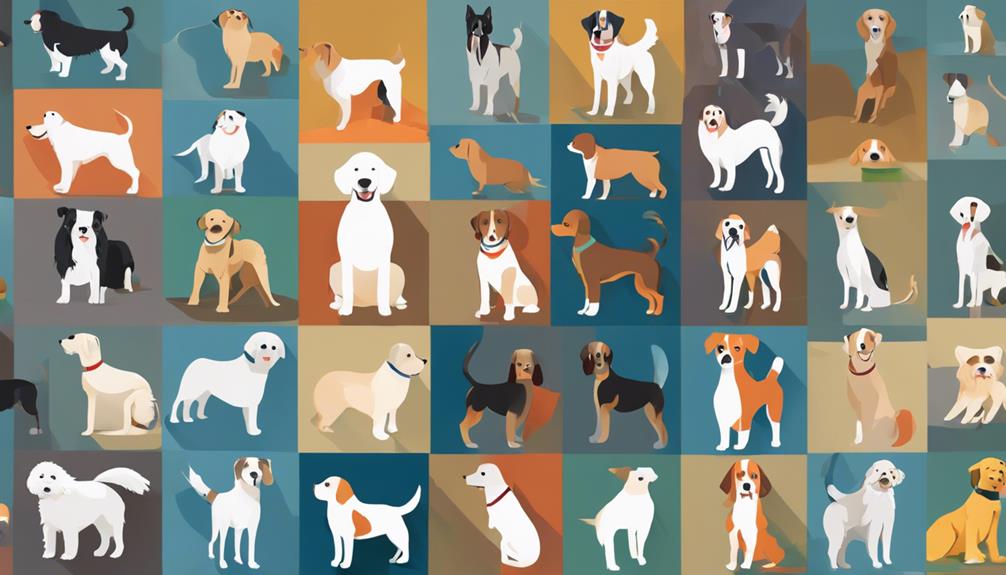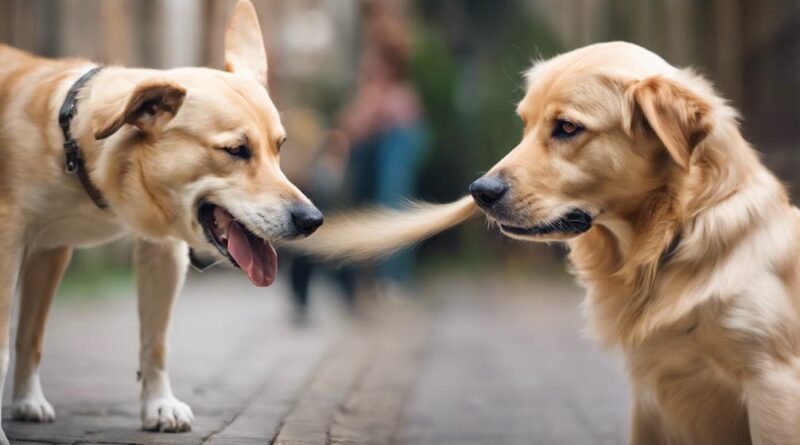5 Reasons Dogs Wag Their Tails: A Dog Psychology Insight
Ever wondered why dogs wag their tails?
You may have heard that tail wagging is simply a sign of happiness, but the reality is much more complex. Understanding the psychology behind this common canine behavior can provide fascinating insights into your furry companion's emotions and motivations.
Intrigued to unravel the mystery behind those enthusiastic tail wags?
Let's explore the multifaceted reasons why dogs engage in this expressive form of communication.
Canine Communication Signals
When observing dogs, their tail wagging serves as a crucial form of communication. Body language plays a significant role in how dogs interact with one another within pack dynamics. The way a dog wags its tail can convey a variety of messages to other dogs and even to humans. For example, a wagging tail held high typically indicates confidence and a friendly demeanor, while a tail tucked between the legs may signal fear or submission. Understanding these body language cues can help you interpret your furry friend's feelings and intentions more accurately.
In pack dynamics, the position and speed of a dog's tail wag can also provide insights into their social status within the group. Dogs at the top of the hierarchy may wag their tails more assertively, whereas lower-ranking dogs might exhibit more submissive wagging patterns. By paying attention to these subtle cues, you can gain a better understanding of the dynamics at play within a group of dogs and how your own pup fits into the pack.
Tail Wagging and Emotional States
Tail wagging in dogs is a key indicator of their emotional states. Understanding your furry friend's wagging tail can give you valuable insights into how they're feeling.
Here are four essential points to consider:
- Canine Body Language: A dog's tail position, along with other body signals, can help you decipher their emotions. For example, a relaxed tail with a slow wag often indicates contentment or relaxation.
- Wagging Speed: The speed at which a dog wags their tail can provide clues about their excitement levels. A fast wag might suggest high arousal or anticipation, while a slow wag could signal calmness.
- Wagging Intensity: The intensity of the tail wag is another factor to pay attention to. A gentle, relaxed wag may indicate friendliness, whereas a stiff and rapid wag could suggest agitation or aggression.
- Interpreting the Whole Picture: Remember to consider the context and your dog's overall body language when analyzing their tail wag. By looking at the complete picture, you can better understand your canine companion's emotional state.
Tail Wagging as Social Bonding
Understanding the significance of dogs wagging their tails goes beyond mere gestures; it's a key aspect of their social bonding behaviors. When dogs wag their tails, they're engaging in bonding behaviors that are essential for communication within their social groups. Tail wagging serves as a form of body language that conveys social cues and helps to reinforce pack dynamics.
In the realm of bonding behavior, tail wagging plays a crucial role in establishing and maintaining social connections among dogs. It's a way for them to express friendliness, submission, or even excitement towards other pack members. By observing the nuances of a dog's tail wagging, you can gain insights into their current emotional state and intentions. Dogs use their tails as a tool for creating harmony within the pack and signaling their willingness to cooperate with others.
Next time you see a dog wagging its tail, pay attention to the context and accompanying body language, as it can provide valuable clues about the social dynamics at play in that canine interaction.
Tail Wagging for Playfulness
Dogs often wag their tails playfully as a sign of excitement and joy during interactions with other dogs or humans. When you observe your furry friend engaging in this behavior, it signifies a positive and playful mood. Here are some insights into why dogs wag their tails for playfulness:
- Expressing Playful Energy: Tail wagging is a common way for dogs to communicate their playful energy. It shows that they're ready for fun interactions and games.
- Signaling Happiness: A wagging tail in a playful manner is a clear indicator of a dog's happiness and enjoyment in the moment.
- Inviting Interaction: Through canine body language, dogs use their wagging tails to invite others to join in their playful antics, encouraging social engagement.
- Strengthening Bonds: Tail wagging during play helps strengthen the bond between dogs and their human companions, fostering a sense of connection and shared joy.
Understanding these cues can enhance your relationship with your dog and create more meaningful moments of play and happiness together.
Tail Wagging and Stress Relief
When your furry companion wags their tail in a relaxed manner, it can serve as a natural way for them to relieve stress and tension. Dogs have a unique way of communicating their emotions through body language, and tail wagging is a significant part of their tail language. Just like humans might fidget or take deep breaths to calm themselves in stressful situations, dogs often resort to wagging their tails as a form of stress relief.
Canine behavior experts suggest that when a dog wags its tail loosely and with a gentle motion, it indicates a sense of relaxation and contentment. This soothing action helps them release pent-up anxiety and worry. Observing your dog's tail movements can provide valuable insights into their emotional state. If you notice your dog engaging in this type of tail wagging, it might be a good idea to create a calm environment to further support their stress-relieving process. Remember, a wagging tail isn't always a sign of playfulness; it can also be a sign of your furry friend seeking comfort and relaxation.
Tail Wagging and Positive Reinforcement
Using treats to reinforce positive behavior can be an effective way to encourage your furry companion's tail wagging. When training your dog, it's essential to understand how positive reinforcement can play a significant role in shaping their behavior. Here are some insights into how tail wagging is connected to positive reinforcement:
- Behavioral Cues: Pay close attention to your dog's behavioral cues when using positive reinforcement techniques. Notice how their tail wagging intensifies when they receive treats for good behavior.
- Training Techniques: Incorporate consistent training techniques to reinforce positive behaviors associated with tail wagging. Repetition and rewards can help strengthen this connection.
- Consistency is Key: Consistency in rewarding your dog for positive behavior is crucial. This helps them understand what actions lead to praise and treats, ultimately encouraging more tail wagging.
- Building Trust: Positive reinforcement not only encourages tail wagging but also helps build trust and a strong bond between you and your furry friend. This trust can further enhance their willingness to engage in desired behaviors.
Tail Wagging and Breed Differences

Tail wagging behavior can vary significantly among different breeds of dogs. Each breed has its own set of characteristics that can influence how they wag their tails. For example, some breeds have naturally short tails, while others have long, flowing tails that wag more prominently. These breed distinctions can affect how dogs communicate through tail wagging.
Certain breeds, like Labrador Retrievers, are known for their enthusiastic and wide tail wags, which often signify their friendly and outgoing nature. On the other hand, breeds such as Greyhounds may have more subtle tail movements due to their calm and reserved demeanor. Understanding these breed-specific traits can help you interpret your dog's tail behavior more accurately.
When observing tail wagging in different breeds, pay attention to the speed, direction, and height of the wag. These subtle cues can provide valuable insights into a dog's emotions and intentions. By considering breed characteristics alongside tail behavior, you can deepen your understanding of how dogs communicate through this universal form of expression.
Tail Wagging and Human Interaction
As you observe your dog's tail wagging behavior, consider how it may be influenced by interactions with humans.
Here are four ways in which human interaction can impact your dog's tail wagging:
- Tail wags and greetings: When you come home, your dog's tail may wag vigorously as a way to greet you. This wagging is a sign of happiness and excitement to see you, showing the strong bond between you and your furry friend.
- Tail wagging and excitement: Engaging in playtime or offering your dog a treat can lead to a rapid and enthusiastic tail wag. This type of wagging indicates your dog's excitement and anticipation, as they enjoy the positive interaction with you.
- Reading human cues: Dogs are incredibly perceptive to human emotions. Your dog may wag their tail gently when you speak to them in a soothing tone, showing they're attuned to your mood and responding positively to your affection.
- Tail position and comfort: Pay attention to the position of your dog's tail during interactions. A relaxed, slow wag suggests contentment and comfort in your presence, while a stiff or low wag may indicate nervousness or discomfort.
Frequently Asked Questions
Can Tail Wagging Ever Indicate Aggression or Fear in Dogs?
When a dog wags its tail, it may not always mean they're happy. Tail language is complex, and misinterpretation can happen.
Sometimes, tail wagging can indicate aggression or fear. It's crucial to pay attention to other body language cues to understand what your dog is feeling.
Dogs communicate through various signals, so learning to read their tail wagging along with other behaviors can help you better understand their emotions.
Are There Any Medical Conditions That Can Affect a Dog's Ability to Wag Its Tail?
If your dog can't wag its tail, medical conditions like tail paralysis, nerve damage, tail amputation, or spinal cord injury might be the culprits. These issues can affect your pup's ability to express emotions through tail wagging.
If you notice any changes in your dog's tail movement or if it seems painful for them to wag their tail, it's best to consult with a veterinarian to determine the underlying cause and provide appropriate care.
Do Different Breeds of Dogs Wag Their Tails in Distinct Ways?
Different breeds exhibit unique tail wagging behavior. Some dogs wag vigorously, while others have more subtle movements. Breeds like Retrievers may have wide, sweeping tail wags, showing excitement or happiness.
In contrast, Terriers might've shorter, faster wagging motions, reflecting their alertness or agitation. Understanding these breed differences can help you interpret your dog's emotions and communication. Pay attention to the nuances in tail wagging—it's a key aspect of canine body language.
Can Dogs Be Trained to Wag Their Tails on Command?
Yes, you can train dogs to wag their tails on command through behavior training. Understanding tail language is key. With consistent positive reinforcement, you can teach your furry friend to wag their tail upon hearing a specific cue.
Tail wagging can convey excitement, happiness, or even nervousness in dogs. By incorporating proper training techniques, you can establish a strong communication channel with your canine companion through their tail movements.
Do Puppies Wag Their Tails Differently Than Adult Dogs?
Yes, puppies wag their tails differently than adult dogs. Puppy behavior, socialization, and tail communication are crucial aspects of canine development.
Puppies often wag their tails in a more enthusiastic and uncoordinated manner compared to adult dogs. This behavior reflects their excitement, curiosity, and playful nature as they navigate the world and interact with other dogs and humans.
Understanding these differences can help in fostering a healthy and happy puppy.
Conclusion
So next time you see a dog wagging its tail, remember that it's not just a simple gesture – it's a complex form of communication. By understanding the reasons behind tail wagging, you can better interpret your furry friend's emotions and strengthen your bond with them.
Pay attention to the speed, height, and direction of the wag to get a better understanding of what your dog is trying to tell you. Happy tail wagging!
